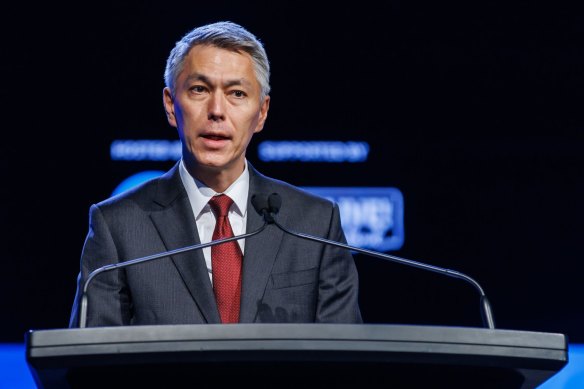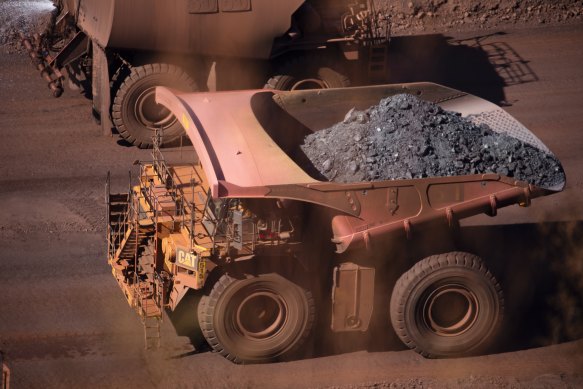This was published 7 months ago
Why copper – not iron ore – is where BHP’s future lies
By Nick Toscano
Mining giant BHP has mapped ambitious new targets to take advantage of the global green energy shift by growing its copper division, as it braces for a slowdown in Chinese appetite for Australia’s most lucrative export, iron ore.
BHP, the largest Australian miner, still earns most of its money from its sprawling mines in Western Australia, where it digs up vast amounts of iron ore and loads it onto ships to be sold to China for processing into steel.

“In the near term, we expect volatility in global commodity markets, with China experiencing an uneven recovery among its end-use sectors”: BHP chief executive Mike Henry.Credit: Bloomberg
But chief executive Mike Henry has been leading a push to boost BHP’s exposure to what he terms “future-facing” commodities, particularly copper, a material the world needs much more of as a critical building block for renewable energy, transmission lines and electric cars.
After walking away from a $US49 billion ($72 billion) offer in May to buy out London-listed rival Anglo American that would have significantly grown its copper business, BHP on Tuesday provided new details on how it intended to expand output from its existing resource base and other projects.
BHP’s copper output has grown by 9 per cent for two consecutive years, and now accounts for 30 per cent of the diversified miner’s revenue. Henry said the company aimed to add another 4 per cent in the coming 12 months, as it mined higher-grade ore at its giant Escondida copper mine in Chile and worked to boost productivity across its other copper assets.
In South Australia, he said, BHP was assessing ways to increase its output of the red metal to 500,000 tonnes a year by the early 2030s, before reaching 650,000 tonnes by mid-decade.
“We have the world’s largest endowment of copper resources,” Henry said on Tuesday. “We are unlocking more of that significant resource base through the plans that we are laying out.”
While describing Anglo American’s rejection of BHP’s takeover offers as “disappointing”, Henry stressed the proposed acquisition had never been the company’s Plan A.
“Plan A is everything that you see outlined in these results, including getting better ... at our ongoing operations, but also unlocking further growth in our existing resource base,” he said. “We continue with Plan A.”
His comments came as Melbourne-based BHP reported it had made an underlying profit of $US13.7 billion ($20.2 billion) in the year to June 30, beating analysts’ forecasts, on the back of record output of iron ore and strong prices.

BHP’s share price has been under pressure amid forecasts of a continued slump in the price of its biggest cash earner, iron ore, which ranks as Australia’s most valuable export commodity.Credit: Krystle Wright
However, Henry flagged it would be a more challenging year ahead, as China, the world’s biggest consumer of metals, faced an uneven economic recovery.
“In the near term, we expect volatility in global commodity markets, with China experiencing an uneven recovery among its end-use sectors,” he said.
On a statutory basis, BHP’s bottom-line profit plunged 39 per cent, dragged down by significant one-off charges, including a multibillion-dollar write-down on the value of its Western Australia nickel assets, which the company mothballed earlier this year following a collapse in global nickel prices.
The board announced a final dividend of US74¢ ($1.09) a share. Combined with the interim dividend announced in February, BHP shareholders will pocket $US1.46 a share ($2.16) for the financial year, down 14 per cent from a year earlier.
BHP’s share price has been under pressure as China’s slowing economy and sluggish property market raise concerns of a continued slump in the price of iron ore. Sales of Australian iron ore raked in more than $130 billion in revenue during 2023-24, up from $124 billion, cementing its position as Australia’s biggest export.
BHP said Chinese steel mills’ blast-furnace rates had been strong in 2023, but were now expected to ease in calendar year 2024 amid subdued steel margins and the potential for policy-driven production controls.
In copper, a near-term slowdown in demand from China’s real estate construction sector was expected to be partly offset by “more positive trends” in investments in expanding the electricity grid and consumer goods, the company said.
RBC Capital Markets analyst Kaan Peker said BHP had posted another strong set of results, which “highlights the consistency of the business, good margins and returns through the cycle”.
“The continued shift towards growth was further spelled out in copper, which adds to the investment case in our view,” he said.
Glyn Lawcock, head of mining research at investment bank Barrenjoey, said BHP’s full-year performance had been largely as expected. But the company’s free cash flow came in 14 per cent stronger than forecasts, resulting in lower net debt, he said.
The Business Briefing newsletter delivers major stories, exclusive coverage and expert opinion. Sign up to get it every weekday morning.